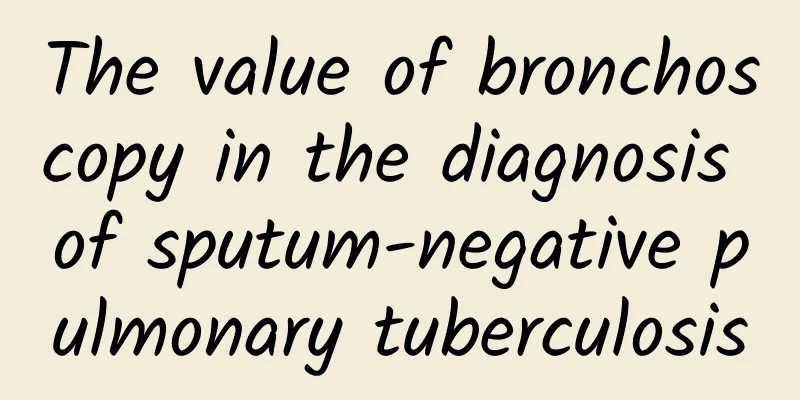The value of bronchoscopy in the diagnosis of sputum-negative pulmonary tuberculosis

|
Negative pulmonary tuberculosis is pulmonary tuberculosis that is negative in sputum tests. Although tuberculosis bacteria are not directly detected, patients may still have symptoms such as coughing, expectoration, and hemoptysis. X-ray examinations can reveal lung lesions. This is mostly due to the decline in immune function, which leads to the proliferation of tuberculosis bacteria. It is common in patients with mild or early symptoms. Diagnosis requires comprehensive symptoms, X-rays, tuberculin tests, etc. Once diagnosed, standardized treatment is required, taking medicines on time, maintaining good living habits, and regular checkups to evaluate the efficacy. Although difficult to detect, standardized treatment is expected to lead to recovery. 1. What is a bronchoscope? A bronchoscope is an endoscope that enters the lower respiratory tract through the mouth or nose. It is used to observe and biopsy bronchial lesions and to examine bacteriology and cytology. It is a fiber endoscope that can assist in the discovery of early lesions and internal surgery. It is suitable for the study of bronchial and lung diseases and postoperative examinations. During the examination, the doctor will use anesthetics to reduce discomfort, but there may still be short-term discomfort. It is not suitable for specific situations, such as patients with unconsciousness or cardiopulmonary insufficiency. In short, bronchoscopy is an important examination method and requires the cooperation of patients to ensure smooth progress. 2. What are the diagnoses for sputum-negative pulmonary tuberculosis? 1. Typical clinical symptoms of pulmonary tuberculosis and chest X-ray manifestations: Patients may show typical symptoms of pulmonary tuberculosis, such as persistent cough, sputum, hemoptysis, chest pain, etc. At the same time, chest X-ray examination can reveal lesions in the lungs, such as lung shadows, nodules, cavities, etc. 2. Anti-tuberculosis treatment is effective: For patients suspected of sputum-negative pulmonary tuberculosis, diagnostic anti-tuberculosis treatment can be performed. If the patient's condition is significantly improved under anti-tuberculosis treatment, then this helps support the diagnosis of sputum-negative pulmonary tuberculosis. 3. Exclude other non-tuberculous lung diseases: When diagnosing negative pulmonary tuberculosis, doctors need to exclude other non-tuberculous lung diseases that may cause similar symptoms, such as pneumonia, lung cancer, etc. 4. Tuberculin test and other laboratory tests: Tuberculin test (such as PPD test) can be used to detect whether the patient has been infected with Mycobacterium tuberculosis. A strong positive reaction may indicate the possibility of active tuberculosis. In addition, laboratory tests such as serum anti-tuberculosis antibody test and PCR test of tuberculosis bacteria in sputum can also be performed to assist in diagnosis. 5. Bronchoscopy: In some cases, doctors may perform bronchoscopy to more directly observe bronchial and lung lesions and perform biopsy or sampling to obtain a more accurate basis for diagnosis. Especially for patients with negative sputum examination, bronchoscopy may have a higher diagnostic value. 3. What is the application value of bronchoscopy in the diagnosis of septic tuberculosis ? Bronchoscopy has the following application values in the diagnosis of sputum-negative pulmonary tuberculosis: 1. Improve the diagnosis rate: Bronchoscopy can directly observe bronchial and lung lesions. For patients with sputum-negative pulmonary tuberculosis, bronchoscopic brush biopsy can significantly improve the positive detection rate of Mycobacterium tuberculosis, thereby increasing the accuracy of diagnosis. 2. Differential diagnosis: Bronchoscopy is helpful for the differential diagnosis of pulmonary tuberculosis, bronchial tuberculosis and lung cancer. These diseases can be distinguished more accurately by observing the morphology and distribution of lesions under the microscope and pathological examination of biopsy tissue. 3. Clarify the scope and stage of the lesion: Bronchoscopy can clarify the scope and stage of the lesion of bronchial tuberculosis, providing a basis for formulating treatment plans. 4. Auxiliary treatment: Bronchoscopy can not only be used for diagnosis, but also for endoscopic treatment, such as sputum suction, local drug injection, etc., which can help relieve patients' symptoms and promote recovery. 5. Evaluate the treatment effect: For patients with negative pulmonary tuberculosis who have received anti-tuberculosis treatment, bronchoscopy can be used to evaluate the treatment effect. By comparing the changes in microscopic lesions before and after treatment, it can be determined whether the treatment is effective and whether the treatment plan needs to be adjusted. 6. Early detection of complications: Bronchoscopy helps to detect possible complications of sputum-negative pulmonary tuberculosis, such as bronchial stenosis and occlusion, at an early stage. The timely detection and treatment of these complications are of great significance for improving the prognosis of patients. 7. Scientific research and teaching: Bronchoscopy also has important application value in the scientific research and teaching of sputum-negative pulmonary tuberculosis. Through the observation and research of a large number of cases, we can gain a deep understanding of the pathogenesis, pathological changes, and diagnosis and treatment methods of sputum-negative pulmonary tuberculosis, providing strong support for future scientific research and clinical practice. Negative pulmonary tuberculosis is pulmonary tuberculosis with negative sputum test. Diagnosis requires comprehensive symptoms, X-rays and laboratory tests. Bronchoscopy, as an important examination method, can directly observe lesions, improve the diagnosis rate, and help differential diagnosis, clarify the scope and stage of lesions. In addition, bronchoscopy can also assist in treatment, evaluate treatment effects and detect complications early, and is also of great value to the scientific research and teaching of negative pulmonary tuberculosis. Although negative pulmonary tuberculosis is difficult to detect, it is expected to be cured through standardized treatment and patient cooperation. In short, bronchoscopy plays an indispensable role in the diagnosis and treatment of negative pulmonary tuberculosis. Author: Hou Tianyong, Taiyuan Fourth People's Hospital, Taiyuan, Shanxi (Pulmonary Hospital Affiliated to Shanxi Medical University) |
<<: How do diet and lifestyle affect the health of your endocrine system?
Recommend
What causes vulva itching?
Women are very great, especially mothers, who are...
Why is my period so light?
Important reminder: Excessive menstrual flow can ...
When to do nt during pregnancy
For many families, pregnancy is regarded as a sac...
What are the benefits of women soaking their feet frequently?
Nowadays, people have some health concepts, so ma...
How many days does it take for a weak positive to become a strong positive during ovulation?
With the change of lifestyle, the probability of ...
What is the cause of bleeding during the warming period?
Ovulation period is a physiological manifestation...
What are the signs of successful fresh embryo transplantation?
There are still many medical methods to treat inf...
The harm of drinking Astragalus water during menstruation
Astragalus is a very important medicinal material...
Are you an apple or a pear? This body type may increase your risk of colorectal cancer...
Compiled by: Gong Zixin Colorectal cancer is the ...
How long after hysterectomy can I have sex?
As we all know, the uterus is a very important re...
Shanghai has it too! The "red, orange, and green" reminders for supermarkets, my mom no longer has to worry about me drinking the wrong beverages!
Remember we reported not long ago that beverages ...
Is it really impolite to play with your phone at a dinner party? What does it mean when friends are always looking at their phones at a dinner party?
Is it really impolite to play with your phone at ...
Can pregnant women suck their stomachs?
In the early stages of pregnancy, mothers are not...
What's going on when the pregnancy test stick doesn't show any results?
Pregnancy test sticks are one of the most commonl...
Women who douching their vagina too often are more likely to get ectopic pregnancy
Women with inflammation of the reproductive tract...









